Kepler 11 - A Unique Extrasolar System
In this month's Naked Astronomy, we explore the unique system of six planets orbiting the star Kepler 11, and find out what to expect from the James Webb Space Telescope. Plus news of the runaway star spotted by WISE - the Wide-field Infrared Survey Explorer, a STEREO view of the whole Sun and how a galaxy spotted at a redshift of 10 can teach us about star formation in the early universe.
In this episode
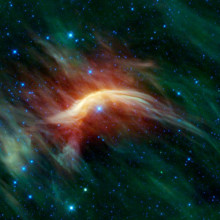
01:47 - WISE Spots Runaway Star
WISE Spots Runaway Star
NASA's WISE mission, or Wide-field Infrared Survey Explorer, has spotted the bow shock of a runaway star. 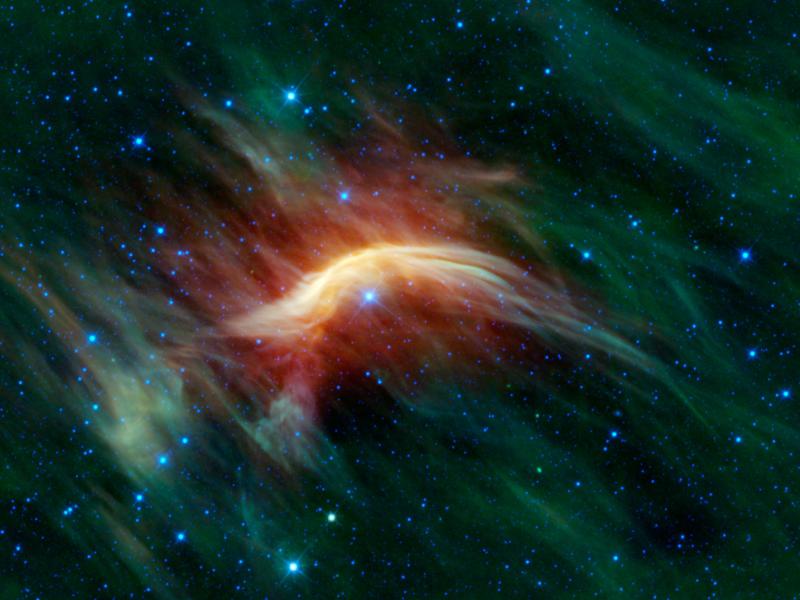 Bow shocks like this are formed as a star hurtles through space at high speed, pushing gas and dust out of it's way and heating it in the process. If heated enough, the gas starts to glow in infra-red, and can be seen by our instruments.
Bow shocks like this are formed as a star hurtles through space at high speed, pushing gas and dust out of it's way and heating it in the process. If heated enough, the gas starts to glow in infra-red, and can be seen by our instruments.
Speeding runaway stars are interesting objects on their own account, but can also help us to learn more about their parent galaxies or clusters...

04:26 - STEREO Sees the Whole Sun
STEREO Sees the Whole Sun
NASA's STEREO mission - a pair of twin probes monitoring the Sun, have now reached 180 degree separation, allowing us a full view of the whole Sun for the first time.
 This allows us to better understand the processes that occur on the Sun's surface, including solar storms and coronal mass ejections. STEREO also gives us 3D imaging of the Sun, allowing us to better place events in space.
This allows us to better understand the processes that occur on the Sun's surface, including solar storms and coronal mass ejections. STEREO also gives us 3D imaging of the Sun, allowing us to better place events in space.
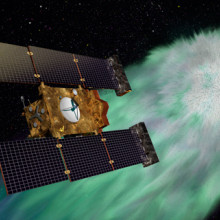
07:45 - Stardust Investigates Comet Tempel 1
Stardust Investigates Comet Tempel 1
The mission Stardust-NExT, to study comet Tempel 1,  made it's closest ever flyby, observing the surface of the comet in unprecidented detail.
made it's closest ever flyby, observing the surface of the comet in unprecidented detail.
Stardust, a "recycled" mission, took images of Tempel 1 to investigate the area hit by the impactor from the Deep Impact mission. This not only gives us new insight into the physical structure of comets, but also how they change as they orbit the Sun.
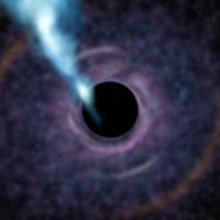
10:43 - Weighing the Black Hole in M87
Weighing the Black Hole in M87
Astronomers using the Gemini telescope have "weighed" the black hole at the centre of the M87 Galaxy. 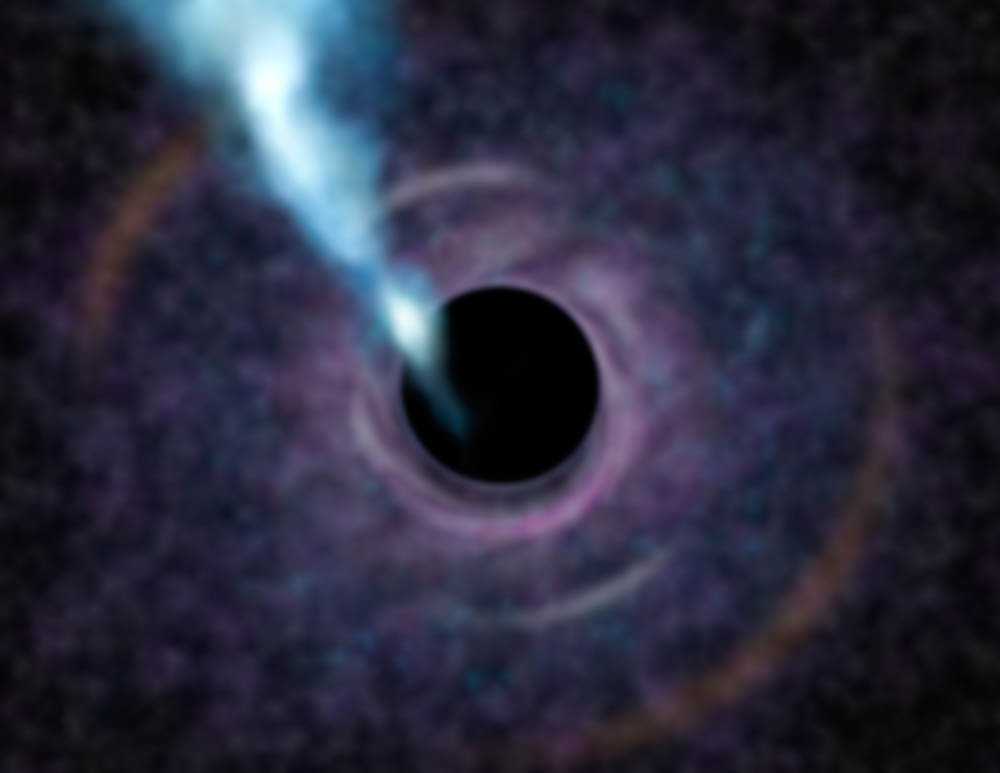 They found it to be mass of 6.6 billion Suns, the largest ever measured for a black hole using a direct technique.
They found it to be mass of 6.6 billion Suns, the largest ever measured for a black hole using a direct technique.
Using the Near-Infrared Field Spectrograph (NIFS) on Gemini, an 8-metre telescope in Hawaii, researchers measured the speed of stars orbiting the centre of the galaxy, and from this were able to calculate the mass of it's black hole...

13:54 - A Galaxy Spotted at Red Shift 10
A Galaxy Spotted at Red Shift 10
A candidate galaxy spotted at a red shift of 10, 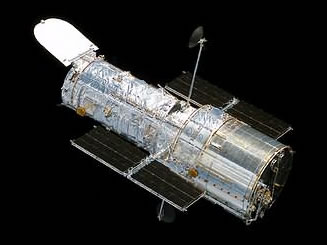 likely to be the most distant object observed so far, gives us a glimpse into the universe in it's infancy.
likely to be the most distant object observed so far, gives us a glimpse into the universe in it's infancy.
The light left this galaxy when the universe was only 500 million years old, and existed at a crucial time when galaxies were first appearing. Understanding star formation in this galaxy could help to shed light on how galaxies first formed...
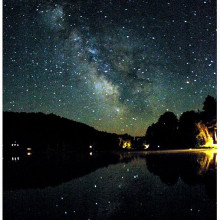
16:48 - Fact Impact - The Milky Way
Fact Impact - The Milky Way
with Carolin Crawford, Cambridge University
- All the stars you can see at night with the unaided eye lie in our home, the Milky Way
- In total, the Galaxy contains around 400 billion stars
- Many of them suns like our own, surrounded by their own planetary systems.
-
 The Milky Way is shaped like two fried eggs back-to-back
The Milky Way is shaped like two fried eggs back-to-back - A large central bulge is surrounded by a flat disc of stars measuring some 120,000 light-years across
- But only a few thousand light-years thick.
- The central bulge of stars is about 12,000 light years in diameter
- It consists of a much older population of stars than found in the disk
- ...and is substantially elongated, making The Milky Way a barred spiral galaxy
- The disc contains the spiral arms, which appear prominent as they contain hot, luminous stars
- They are sites of active star formation, and are lined with glowing gas nebulae and young blue star clusters
- Where stars have formed in groups, all originally having collapsed from the same dense molecular cloud.
- The Galaxy has four spiral arms; known as the Perseus, Scutum-Crux, Carina & Sagittarius, and Norma & Cygnus arms
- The Sun lies halfway out from the centre to the edge of the stellar disc
- And is located in the Orion arm, a small outer spur of the Cygnus arm
- All the stars in the disc - including the Sun - are rotating in near-circular orbits
- The Sun is orbiting at a speed of around 220 km/s, moving in the direction of the star known as Vega
- Even at that speed, it takes us around 250 million years to travel once round the centre of the galaxy.
- Detailed study of the speeds of stars in the rotating disc reveals that the mass of the Galaxy is around eight hundred thousand million times the mass of the Sun
- But over 90% of this mass is in the form of an invisible giant halo of dark matter, which only reveals itself by its gravitational pull on the visible matter
- Its mass is so great that it is gravity of the dark matter (rather than of all the stars) that holds the galaxy together.
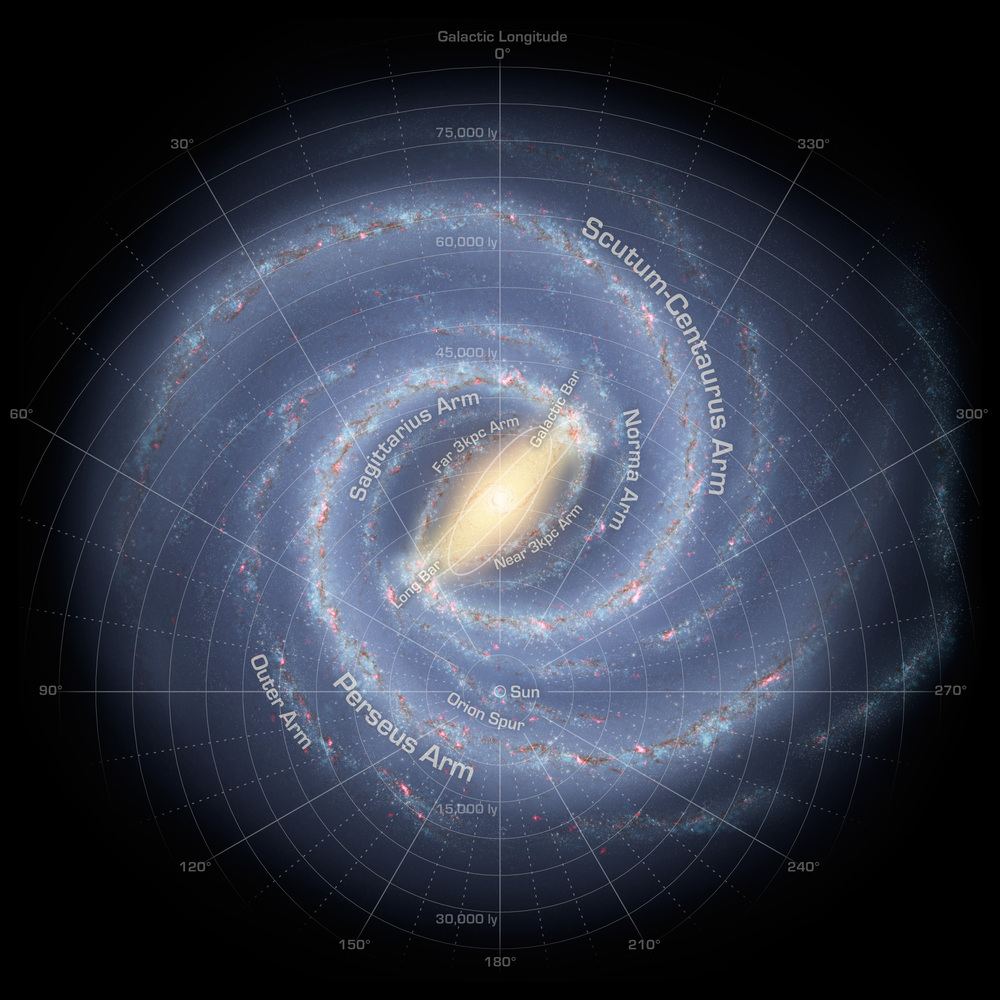
- The centre of the Milky Way lies in the direction of the constellation of Sagittarius, and is some 30,000 light-years away from us
- It is marked by intense radio feature, called Sagittarius A*, which is surrounded by a cluster of hot young stars
- Many of these stars are moving very fast in tight orbits around a mass some 4 million times that of the Sun
- Which must be contained within a volume less than the size of our Solar System
- This is the evidence that the core of our Galaxy hosts a super-massive black hole
- Which remains dormant, not actively accreting any matter.
- The Milky Way is not alone in space
- Along with its sister galaxy Andromeda and the Triangulum Galaxy, it is part of the 'Local Group', a collection of around 25-30 galaxies spread over a region some 10 million light-years across
- Which in turn is at the outskirts of the Virgo supercluster of galaxies, some 150 million light-years in diameter.
- Two of the small galaxies in orbit around the Milky Way can be seen in the Southern hemisphere night sky
- Known as the Magellanic clouds, they lie 160,000 and 200,000 light years away
- ...and are slowly being distorted and pulled apart by the tidal forces from the Milky Way's gravity.
- A new satellite galaxy was only discovered in 1994, and it is known as the Sagittarius Dwarf Elliptical Galaxy (SagDEG)
- It moves in a polar orbit very close to the Milky Way, but is currently on the opposite side of the Galactic Center from the Solar System
- ...and is also being shredded by the Galaxy's gravitational pull, shedding a long stream of stars in its wake.
- The close proximity of such satellite galaxies as the Magellanic clouds and SagDEG have in return affected the Milky Way
- Their tidal gravitational forces have slightly warped the disc of the MW so it is not completely flat.
- The Milky Way is on a collision course with its near neighbour, the Andromeda galaxy
- They are heading towards each other at a rate of about 500,000 kmph
- ...and the two galaxies are expected to begin the process of merging within a few billion years.

Can a rotating ship simulate gravity?
Why don't galaxies that are not rotating collapse?

27:51 - The Unique System of Kepler 11
The Unique System of Kepler 11
with Dr Jack Lissauer, NASA Ames Research Center
NASA describes Kepler as their first mission capable of finding Earth-size planets around other stars - 
' alt='Artist's conception of a simultaneous transit of three planets before Kepler-11 observed by NASA's Kepler spacecraft on Aug. 26, 2010.' >and it's doing a very good job. In the journal Nature earlier this month, NASA scientists announced the discovery of a unique system of 6 stars orbiting very close to their parent star, Kepler 11. I spoke to Dr Jack Lissauer...

41:34 - Is Hawking radiation more to do with energy than mass?
Is Hawking radiation more to do with energy than mass?
This is Ben Main's complete question - for Andrew's answer, please listen to the podcast...
I was listening to the most recent episode of Naked Astronomy and in particular I noted Andrew Pontzen's response to the question from David Walker about whether there was a bias as to whether a particle or an antiparticle fell into a black hole in the particular depiction of Hawking radiation where such a pair of particles is produced around the event horizon.
Now, I am not a physicist, but it seems to me that Andrew's explanation was just plain wrong. It seems to me that it does not matter whether the particle that escapes the black hole is a particle or an antiparticle...the black hole will lose mass equivalent to the energy of the particle emitted, so no bias in absorbing particles or antiparticles need exist.
The issue is not whether matter or antimatter falls into a black hole--in both cases, the black hole will grow by the mass of the objectI think that it's helpful to think of this in terms of the equivalency of matter and energy. In this view, matter and antimatter are two different manifestations of energy that have the property of transforming into gamma radiation when corresponding particles of the two types (like a positron and an electron, a proton and an anti-proton, etc.) interact.
However, this interaction does not destroy the energy of the two particles. Instead, it is emitted in the gamma radiation from the reaction. As such, such an interaction occurring within the event horizon would have no effect as regardless of the form of the energy, it would continue on toward the singularity. An antiparticle falling into a black hole makes the black hole more massive because antiparticles, just like their matter counterparts consist of a positive amount of energy.
So an antiparticle annihilating with a bit of matter falling into a black hole would not have any effect on the black hole's end mass - the gamma photon produced would still become a part of the black hole's mass, which is merely a manifestation of its energy.
So how does the conventional Hawking radiation explanation work? In works on the properties of virtual particles, which come in and out of existence with no net change in energy. In the case of Hawking radiation, a matter-antimatter pair form around the event horizon and one of the pair leaves the black hole's gravitational pull while the other falls in.
While it would seem that the one falling in would make the black hole larger, it must be remember that these particles came into being out of no energy and so the black hole ends up paying the "debt" of the particles' creation with its mass and this debt happens to be twice as large as the particle that fell in, as the other one escaped.
Ben MainNeenah, WI, USA

Could extremophile bacteria survive on Mars?
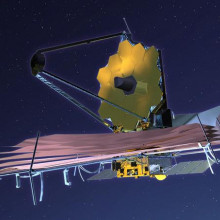
48:28 - The James Webb Space Telescope
The James Webb Space Telescope
with John C. Mather, NASA
The James Webb Space Telescope, planned for launch in 2014, will be NASA's scientific successor to Hubble. 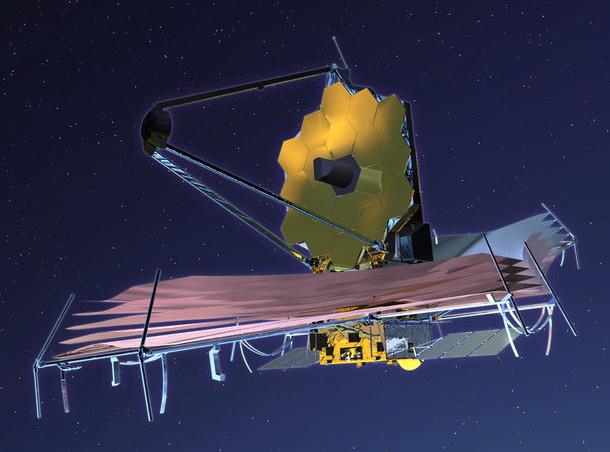 With a larger mirror and infrared observing capabilities, it is hoped that the James Webb will be able to image and study the objects that Hubble wasn't able to. Louise Ogden spoke to Nobel Laureate John C. Mather, the project scientist for the James Webb Telescope about its projected capabilities...
With a larger mirror and infrared observing capabilities, it is hoped that the James Webb will be able to image and study the objects that Hubble wasn't able to. Louise Ogden spoke to Nobel Laureate John C. Mather, the project scientist for the James Webb Telescope about its projected capabilities...
How can we be sure about the age of the universe?

Where matter slows light, is spacetime affected?
Related Content
- Previous Where do Melons Get their Water?
- Next Our Place in the Cosmos!










Comments
Add a comment